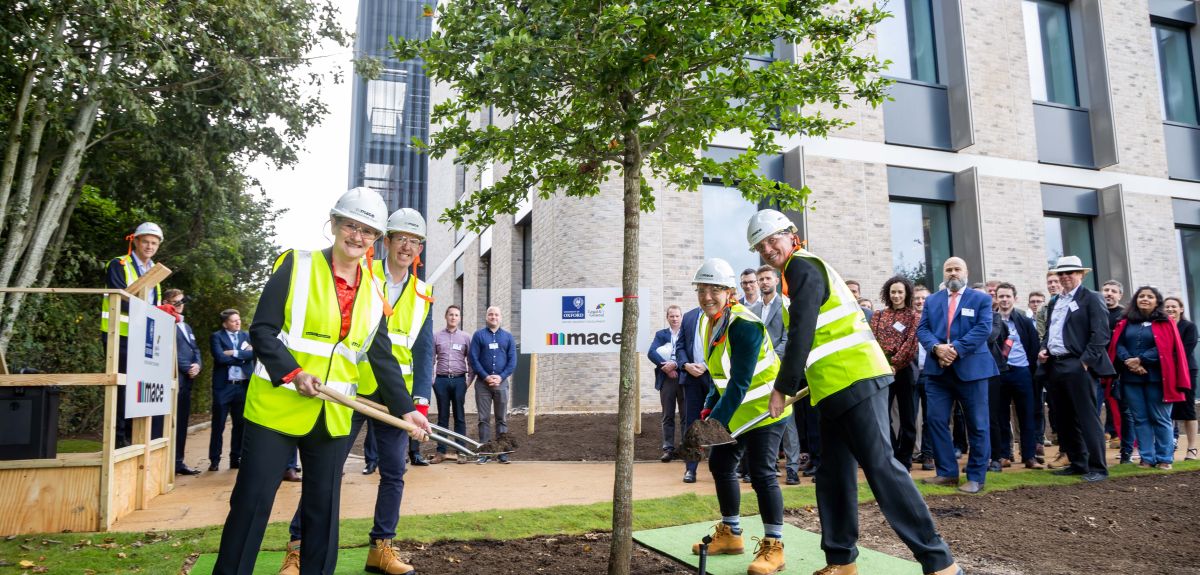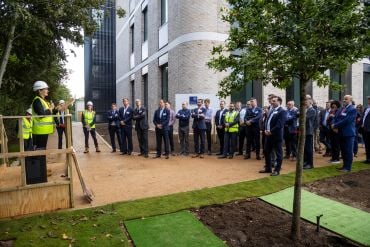
Tree planted at Begbroke Science Park to mark structural completion of new University science buildings
The new buildings will provide highly flexible new office and laboratory space, almost doubling the Science Park’s usable internal area.
A tree-planting ceremony took place today (Monday 18 September 2023) at Begbroke Science Park, marking the completion of major structural work on two buildings that are under construction there to provide new space for research and innovation.
This £59m project is the latest milestone in the wider £4 billion partnership between the University of Oxford and Legal & General (L&G). It is managed by Oxford University Development (OUD).
The new buildings at Begbroke are expected to be ready for handover by main construction partner Mace in early 2024, providing around 12,500m2 of highly flexible new office and laboratory space and almost doubling the Science Park’s usable internal area. One of them will be occupied by University academic groups; the other will hold research spinouts and other innovative private sector partners.
These two new buildings will provide a fantastic new setting for science, collaboration and knowledge-sharing, creating new jobs and supporting the growth of Oxford’s flourishing innovation economy
Professor Irene Tracey, Vice-Chancellor, Oxford University
‘Begbroke Science Park is a vital part of the University's research and innovation infrastructure,’ said Professor Irene Tracey, Vice-Chancellor of Oxford University.
‘It's also a key enabler of our future development, as we seek to build on its unique strengths in bringing together science and industry to harness our researchers' world-leading expertise and tackle an ever-wider range of real-world challenges. These two new buildings will provide a fantastic new setting for science, collaboration and knowledge-sharing, creating new jobs and supporting the growth of Oxford’s flourishing innovation economy.’
Professor Tracey, L&G Group Chief Executive Sir Nigel Wilson, OUD CEO Anna Strongman and Rob Lemming, Director of Life Sciences and Pharmaceuticals Construction at Mace, planted a Nyssa sylvatica or black tupelo tree. This will form a focal point in the landscaped green space around the two new buildings.
‘The two new science buildings at Begbroke form an important part of our mission to deliver world-class research facilities and incubator space,’ said Anna Strongman. ‘By purposefully curating academic facilities alongside commercial space, we can nurture the ever-growing number of spinouts emerging from the University, which are delivering new scientific discoveries that will change the world.’
Vibrant new community
The new facilities will help the University to build on Begbroke’s impressive track record of fostering research breakthroughs and the development of new and transformative technologies. The Science Park has helped to enable an extraordinary range of scientific activities, many of which have spun out into globally successful companies in their own right.
 Professor Irene Tracey addresses invited guests
Professor Irene Tracey addresses invited guestsIn the longer term, the University and its joint venture partners are also moving forwards with a much more ambitious set of plans to create a unique innovation district with the expanded Science Park at its heart.
The aspiration is to create a vibrant new community built on research, innovation and sustainability, with large amounts of additional R&D space, as well as around 1,800 affordable, energy-efficient new homes for both University staff and the public, and superb local amenities including schools, nurseries, sports and leisure facilities, shops, cafes and new sustainable transport links – all set amid wildlife-friendly green space that will help increase biodiversity on the site by at least 20%.
 Expert Comment: Chatbot-driven sexual abuse? The Grok case is just the tip of the iceberg
Expert Comment: Chatbot-driven sexual abuse? The Grok case is just the tip of the iceberg
 New study finds that stopping weight-loss drugs is linked to faster regain than ending diet programmes
New study finds that stopping weight-loss drugs is linked to faster regain than ending diet programmes